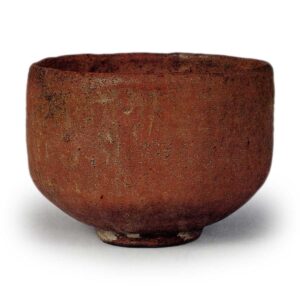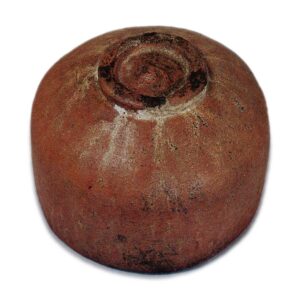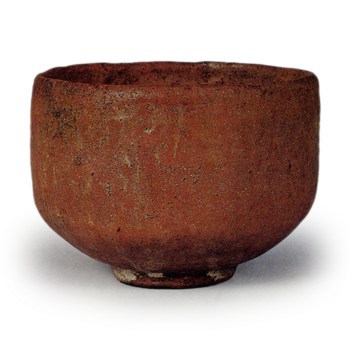

Important Cultural Property
Height 8.6cm, Bore 10.8-11.2cm, Base 4.8cm in diameter
Yugawa Art Museum
On the front of the inner box cover, Sen Soshitsu wrote “Muichimono Soshitsu (Hanashii)” (sealed with a flower).
Later, Matsudaira Fumai, who treasured this tea bowl, prepared the outer box and inscribed “Muichimono akachakai” on the front of the lid. After Seso, the origin of this bowl is not known, but it later came into the possession of Shimizu Fujitaro in Kyoto, and then into the collection of Matsudaira Fumai.
This is a representative work of Chojiro’s red tea bowls together with “Ichimonji,” and I guess that this type of bowl is typical of the style favored by Rikyu. The mouth is slightly held inward, similar to the “Okuro”, and the body is plump and rounded, and the shape of the body quietly shrinking from the waist to the base is the ultimate in randomness, and the inscription of “Muichimono” must have been related to the taste of this bowl. In the case of this tea bowl, too, the height is small compared to the diameter, and the tatami mat is rounded to create a gentle appearance, and the inside of the height is clearly carved with a spiral helmet. Also, among the Chojiro ware tea bowls we have seen, the unusually thick bottom is also a characteristic of this tea bowl, and therefore it is quite heavy to handle.
It is said that the entire body was covered with a transparent glaze, but perhaps because the glaze was thin and the firing temperature was low, the glaze skin is almost white and seems to be thinly adhering to the clay skin. In particular, the interior of the vessel is largely unglazed, revealing the reddish-black clay. The red clay is the same as that used for “Ichimonji” and “Shishi” tiles, and is probably what is known as “Juraku” clay. There are five clear marks on the takadai tatami mats.



